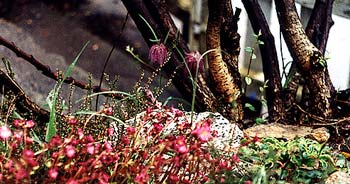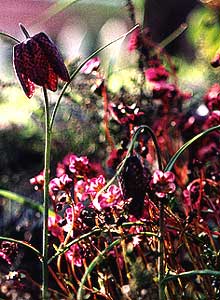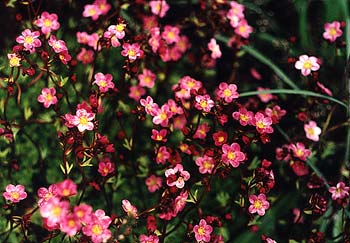 Saxifraga x arendsii 'Triumph,' a reliable stand-by
Saxifraga x arendsii 'Triumph,' a reliable stand-by
The 'Triumph' cultivar of the hybrid Saxifraga x arendsii has become a popular rockery plant because it is so adaptable. The S. arendsii group of hybrids have a complex crossbred heritage including S. hypnoides, S. moschata, S. rosacea & S. exarata.
It prefers somewhat alkaline soils, but it thrives even in our natural Northwest acidic soils without requiring pH amendment. It prefers to be kept moderately moist, but will make it through patches of drought pretty easily (overwatering can be harder on it than underwatering). Ideally it is given about half sun & half shade, but will tolerate more shade & get by in a lot of sun.
 If an accumulation of conditions are too poor for it, the mossy-carpet appearance will thin out & show dark dead-looking interior parts. When we first got a small pot of it, we planted it in a moist area & it soon looked thin homely showing the black interior under its green leaves. But when we moved it to an area of sedums that were watered less often, the saxifraga bounced back swiftly & spread from small pot-sized to a two-foot wide mossy patch. So by & large it is a forgiving plant, cold-hardy, self-seeding, & spreading reliably but not invasively.
If an accumulation of conditions are too poor for it, the mossy-carpet appearance will thin out & show dark dead-looking interior parts. When we first got a small pot of it, we planted it in a moist area & it soon looked thin homely showing the black interior under its green leaves. But when we moved it to an area of sedums that were watered less often, the saxifraga bounced back swiftly & spread from small pot-sized to a two-foot wide mossy patch. So by & large it is a forgiving plant, cold-hardy, self-seeding, & spreading reliably but not invasively.It's primarily limitation is it will not thrive in hot climates. Many of the original species plants for S. x arendsii are native of the far north & can even be found above the Arctic Circle. So there is not much hot weather in Triumph's heritage. Still, it'll make it through a little heat from time to time when it has to.
The surface-spreading mossy leaves are evergreen for year-round effect. From April through June it sends up ten-inch-tall stems with bright pink & red flowers. This flowery carpet has spread just enough to embrace a few checkered lilies which add to that patch's prettiness in spring. The photos on this page show some of the checkered lilies too.
 Some people really love Saxifraga & set up rock gardens of a dozen different varieties, & ther is even an international Saxifraga Society for devotees. This genus of flowers has considerable diversity not only in color & shape of bloom but of leaf as well. We have Saxifraga dentata for example, which looks more like a succulent & you'd be hard pressed to tell it is a relative of the mossy groundcover. This is why many saxifrage fans distinguish the S. x arendsii & similar types of hybrid & species Saxafraga as "mossies."
Some people really love Saxifraga & set up rock gardens of a dozen different varieties, & ther is even an international Saxifraga Society for devotees. This genus of flowers has considerable diversity not only in color & shape of bloom but of leaf as well. We have Saxifraga dentata for example, which looks more like a succulent & you'd be hard pressed to tell it is a relative of the mossy groundcover. This is why many saxifrage fans distinguish the S. x arendsii & similar types of hybrid & species Saxafraga as "mossies." The cultivar Triumph is one of the most often available of some 40 S. x arendsii hybrids. So it is nothing particularly unusual or rare among the hundreds of saxifrage species plus endless numbers of hybrids that exist. Many saxifrages are very sensitive in the garden & really only for devoted specialists. But Triumph is an easy, pleasant & reliable little fill-in, interesting for its own sake in an Alpine rockery setting with dwarf rhodies, & especially good for its mossiness in breaking up the texture of a rock garden that could otherwise be too reliant on sedums.